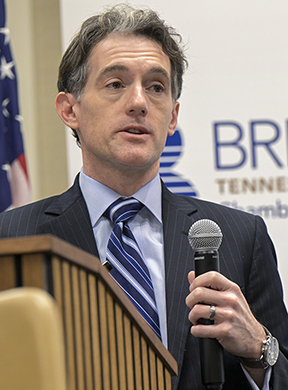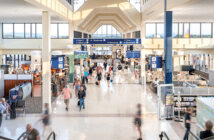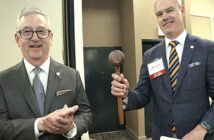
By Dave Ongie, Managing Editor
“Keep on the Sunnyside” was a tune made popular by the Carter Family, who figured prominently in the groundbreaking Bristol Sessions that served as the “Big Bang” of modern country music.
When Curtis Dubay, Chief Economist for the U.S. Chamber of Commerce took the stage to give the keynote address during last Friday’s Bristol Chamber of Commerce Awards Luncheon, he admitted at the outset of his remarks that any rays of sunshine would come in the form of a silver lining around gathering clouds. Dubay told those in attendance that we have reached “an important inflection point.” Strong consumer spending that has kept the economy afloat throughout the COVID-19 pandemic and into its aftermath has now slowed, paving the way for a recession.
“We’re going to have a slow 2023 and a reasonably slow 2024,” Dubay said, adding that experts say there is a 65 percent chance of a recession in 2023.
In Dubay’s estimation, it was surprising that strong consumer spending was able to carry on so long given the strong headwinds of rising inflation in 2022. As of last November, annual wage growth was 4.6 percent, but inflation was up 7.1 percent annually. In short, growth in wages was far outstripped by the pace of inflation.
Dubay’s data indicates that consumer spending was propped up by savings accounts that were full of stimulus dollars. Excess pandemic savings peaked at close to $2.7 trillion, but savings were below pre-pandemic levels throughout 2022 due to inflation.
With savings down, credit card debt is predictably on the rise. After bottoming out in January of 2021, consumer credit debt has been rising steadily, another byproduct of inflation Dubay said was caused primarily by quantitative easing during the pandemic.
“The main culprit was the 8 trillion dollars pumped into the economy,” Dubay said, adding that supply chain issues, worker shortages and a rush of demand after the economic shutdown during the spring and summer of 2020 were also contributing factors to the runaway inflation that forced the Fed to begin rapidly raising interest rates.

Photo by Earl Neikirk
More evidence to back Dubay’s claims on consumer spending could be found in a study by Visa that showed consumer spending slumped by 1.1 percent between November and December of 2022, the largest month-to-month drop of the year. Furthermore, Visa’s Principal U.S. Economist Michael Brown said a $1 million decline in online shopping in December rules out frigid temperatures and snowfall in the days leading up to Christmas as the major reason for the drop in retail sales.
Although Dubay’s data shows consumer sentiment rose slightly in January, it is still low historically and much lower than it was at the beginning of the COVID-19 lockdown. The fact that food-at-home prices in November of 2022 were up 12 percent annually is a prime example of how thin household budgets are being stretched.
Looking ahead to 2023, Dubay said higher interest rates will further curtail demand in all sectors of the economy. Rates are likely to recede as the year goes on after rapid increases last year. Prices are also likely to stop rising as inflation comes under control, but Dubay said not to expect any drastic price reductions in the near term.
It all adds up to a period of dampened economic growth, which Dubay said is to be expected whenever interest rate hikes are implemented to control inflation. However, Dubay said there is plenty of evidence that any recession has a good chance of being short-lived.
“After a bad economic shock, sectors of the economy are shown to be weak,” Dubay said, adding that the housing bubble in 2008 cascaded through the economy exposing weaknesses throughout. “That didn’t happen during COVID or through inflation. That shows me the fundamentals of the U.S. economy are strong.”
Evidence of the strong fundamentals of our economy can be seen in third-quarter data and recent hiring trends. The economy grew at 3.2 percent in the third quarter and employers added 223,000 jobs in December as the labor force grew by 439,000.
Another silver lining is that layoffs are not likely during this particular recession. At the end of October, there were 10.3 million job openings, 4.3 million more than unemployed workers. Dubay believes employers who have been working so hard to entice workers back into the job market aren’t likely to make labor cuts anytime soon.
When it comes to the continuing work shortage, Dubay admits he’s at a loss to explain how workers who left the workforce during the COVID-19 shutdown in 2020 have managed to stay away for so long. He speculates that families have prioritized having a parent home to raise their children or even homeschool them in some cases over having two incomes, but he doesn’t believe that is enough to explain all 3 million people who left the workforce and still haven’t come back.
“There should be people coming back to the workforce,” he said. “I don’t have a cohesive story to explain this.”



